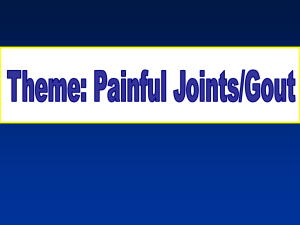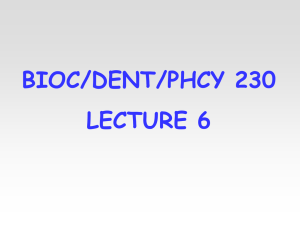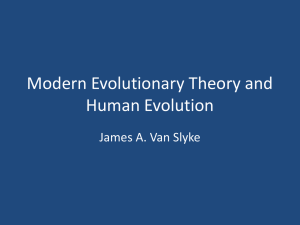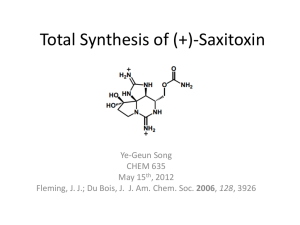2004 Lec 42-43: Nucleotide Metabolism
advertisement
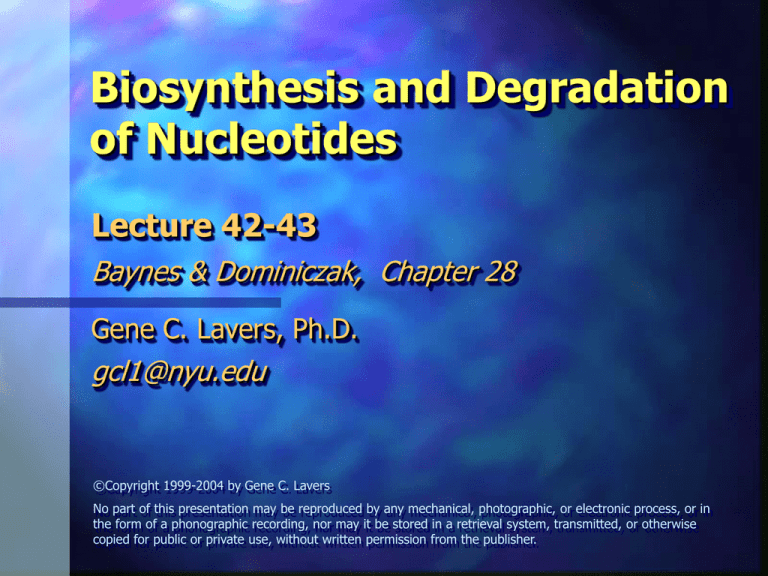
Biosynthesis and Degradation of Nucleotides Lecture 42-43 Baynes & Dominiczak, Chapter 28 Gene C. Lavers, Ph.D. gcl1@nyu.edu ©Copyright 1999-2004 by Gene C. Lavers No part of this presentation may be reproduced by any mechanical, photographic, or electronic process, or in the form of a phonographic recording, nor may it be stored in a retrieval system, transmitted, or otherwise copied for public or private use, without written permission from the publisher. Purine and Pyrimidine Parent heterocyclic compounds Nucleic Acid Metabolism Fig. 28.1 Structure of purines and pyrimidines. ©Copyright 1999-2004 by Gene C. Lavers, Ph.D. 2 Purine and Pyrimidine Family Bases, nucleosides, nucleotides D + O2 Nucleic Acid Metabolism N9-H N– + H+ basic N Purines and pyrimidines are semi- aromatic ring systems p-p bonds similar to benzene Bases stack vertically Ribose in RNA; deoxyribose in DNA (d)Base-sugar = (d)nucleoside (d)Base-sugar-PO4= = (d)nucleotide Base-pairs A = T or T = A A=U or U=A C G or G C A C G U are in RNA dA dC dG dT are in DNA Fig. 28.2 Names of purine and pyrimidines. ©Copyright 1999-2004 by Gene C. Lavers, Ph.D. 3 Metabolic Roles Nucleotides Nucleic Acid Metabolism Introduction DNA and RNA Synthesis Protein Synthesis Glycogen Synthesis Oxidative Phosphorylation Signal Transduction Muscle Contraction Electrolyte Balance Coenzymes Allosteric regulators dNTP, NTP ATP, GTP UDP-glucose ADP/ATP cAMP cGMP ATP ATP NAD FAD CoA ATP, AMP … ©Copyright 1999-2004 by Gene C. Lavers, Ph.D. 4 Purine synthesis Ten steps ( 5 + 5) IMP Nucleic Acid Metabolism Cytoplasm PRPP used in other Rx 1. 1PRaPP + NH2 PRbNH2 2. Amide with gly; ATP used 3. 1-carbon (C8) N10-THFA 4. Gln amidine (N3) 5. Ring-closure – H2O 6. CO2 (C6) 7. Asp (N1) [i.e., urea cycle] 8. fumarate 9. 1-carbon (C2) N10-THFA 10. Ring-closure – H2O Fig. 28.3 Metabolic pathway for synthesis of purines ©Copyright 1999-2004 by Gene C. Lavers, Ph.D. 5 IMP AMP and GMP Branched pathway D + O2 Nucleic Acid Metabolism Cytoplasm IMP common precursor for AMP and GMP AMP – GTP (GDP) cross-substrate for AMP synthesis – Adenylosuccinate similar to urea cycle compound – fumarate + AMP GMP – Oxidation (NAD+) yields xanthine-5’P (XMP) – ATP (AMP + PP2Pi) amination (gln) amide yields GMP Energy cost – IMP synthesis costs 4 ATP – AMP synthesis costs GTP (or 5 high energy bonds) – GMP synthesis costs ATP (or 6 high energy bonds) Purine synthesis is proportional: A > G Phosphorylations – AMP ADP ATP – GMP GDP GTP Fig. 28.4 Conversion of IMP to AMP and GMP. ©Copyright 1999-2004 by Gene C. Lavers, Ph.D. 6 Purine synthesis Control and Salvage of IMP, AMP and GMP Nucleic Acid Metabolism Cytoplasm Control of Purine Synthesis Product inhibition by AMP and GMP from IMP Cross-nucletide co-substrates required balanced synthesis Allosteric feedback inhibition of PRPP-Gln amidotransferase Salvage of free bases Nucleosides and nucleotides spontaneously hydrolyze N-b-glycosidic bond free base released catabolized to urate De novo synthesis of purines minimized by 1-step conversion back to nucleoside-5’P – Adenine + PRPP AMP – Hypoxanthine + PRPP IMP – Guanine + PRPP GMP via A-PRTase via H-PRTase H-PRTase Gout and Lesch-Nyhan syndromes Salvage enzymes deficient (0.1% in brain gives Lesch-Nyhan psychiatric behavior) – Up to 5-fold extra de novo synthesis leads to excessive accumulation of urate. – Urate is sparingly soluble; needle crystals form in joints and kidneys gouty arthritis and kidney damage. Untreated L-N children die in teenage years – renal damage failure. Treatment: inhibition (X) of XO by allopurinol prevents excessive purine base catabolism to urate, i.e., ade hyp —X xan —X urate (Fig 28.5), thereby limiting excessive purine synthesis that occurs in untreated patients ©Copyright 1999-2004 by Gene C. Lavers, Ph.D. 7 Azaserine Diazo-containing Antibiotics Purine Nucleotide Biosynthesis Clinical 1. Glutamine analogs as affinity labels. Azaserine and 6-diazo-5-oxo-norleucine 2. Diazo-containing antibiotics bind in active site of amidotransferase. Diazo group alkylation of nucleophilic cysteine residue in enzyme’s active site. 3. Expect many enzymes with Gln as substrate would be inactivated by diazo-containing antibiotics. O O H 2N NH2 glutamine O OH N=N=C H O O azaserine NH2 O OH N=N=C H O OH NH2 6-diazo-5-oxo-norleucine ©Copyright 1999-2004 by Gene C. Lavers, Ph.D. 8 Catabolism of Purines Nucleic Acid Metabolism Allopurinol treatment of gout and Lesch-Nyhan syndromes Fig. 28.5 Inhibition of xanthine oxidase (XO) by alloxanthine is the mechanism involved in allopurinol treatment of gout and LeschNyhan syndromes. ©Copyright 1999-2004 by Gene C. Lavers, Ph.D. 9 Pyrimidine Synthesis Multifunctional enzymes, CAD and UMP synthase Nucleic Acid Metabolism CP made by carbamoyl phosphate synthetase different from CPS that makes CP in urea cycle. In prokaryotes individual enzymes In eukaryotes 3 + 2 multifunctional enzymes Dihydroorotate dehydrogenase linked to ETS via ubiquinone 2 ATP. Dihydroorotate oxidized to orotate by mitochondrial enzyme. PPRP + orotate orotate nucleotide UMP + CO2 UMP UDP UTP (gln) CTP Fig. 28.6 Metabolic pathway for the synthesis of pyrimidines. ©Copyright 1999-2004 by Gene C. Lavers, Ph.D. 10 Biosynthesis of CTP and TTP THFA vs. DHFA and chemotherapy Nucleic Acid Metabolism Cytosol Fig. 28.7 Synthesis of pyrimidine triphosphates. Inhibited at the indicated sites by • fluorodeoxyuridylate (FdUMP) • methotrexate • aminopterin • trimethoprim ©Copyright 1999-2004 by Gene C. Lavers, Ph.D. 11 Ribose to Deoxyribose Nucleic Acid Metabolism Cytoplasm Ribonucleotide reductase H+ + NADPH Thioredoxin reductase NADP+ FAD FADH2 Glutathione reductase Glutathione Thioredoxin Glutaredoxin Ribonucleotide reductase PPO Base O PPO 2 Base O 2 OH H OH OH ©Copyright 1999-2004 by Gene C. Lavers, Ph.D. 12 Uracil to Thymine: 1-carbon fragment on folate Dihydrofolate: dead-end metabolite Deoxy Nucleic Acids Enzymology Fudr (fluorodeoxyuridate) cytoplasm Suicide inhibitor dUMP TMP synthase 1 FH2 N5,N10-CH2-FH4 glycine 3. Serine hydroxymethyl transferase serine dTMP NADPH + H+ 2. Dihydrofolate reductase FH4 Rib5P Pentose Shunt NADP+ aminopterin Glc6P methotrexate (amethopterin) ©Copyright 1999-2004 by Gene C. Lavers, Ph.D. 13 DHFA Reductase Deoxy Nucleic Acids Enzymology Chemotherapy cytoplasm N H 2N N H N 5 N dUMP dTMP H Thymidylate synthase HO H C N10 2 N5N10methyleneTHFA N H 2N H N R HO Dihydrofolate DHFA 5 N N H 10 (Glu) O O H 2N N NH2 N (Glu)n 5 N N H 2N H N N HN 10 R = H, aminopterin R = CH3, methotrexate N (glu)n OCH3 OCH3 OCH3 NH2 ©Copyright 1999-2004 by Gene C. Lavers, Ph.D. trimethoprim 14 Deoxyribose and Thymine Nucleic Acid Metabolism Overview cytoplasm ribose deoxyribose NMP NDP Ribonucleoside bisphosphate reductase pp NTP dUMP TMP synthase DNA dCTP DNA dNTP dNDP 1 dATP dGTP DNA dUTP 2 dTMP dTTP ©Copyright 1999-2004 by Gene C. Lavers, Ph.D. DNA 15 Synthesis, Catabolism, Salvage C.P. Asp Pyrimidine Metabolism Overview 3 steps Orotate 1 enzyme 2 Pi PRPP PPi UMP “OMP” CO2 Glycogen UDP UTP dUDP dUMP Cyd dTMP Urd dTTP Thd RNA CTP ? Cyt ©Copyright 1999-2004 by Gene C. Lavers, Ph.D. Ura b-Ala Thy 16 2-MeBu Biosynthesis and Degradation of Nucleotides END ©Copyright 1999-2004 by Gene C. Lavers, Ph.D. 17

